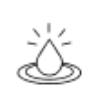“Empty your mind, be formless. Shapeless, like water. If you put water into a cup, it becomes the cup. You put water into a bottle and it becomes the bottle. You put it in a teapot, it becomes the teapot. Now, water can flow or it can crash. Be water, my friend.” – Bruce Lee
In large part, you already are. The human body comprises over 60% water, echoing the surface area of our earth, which is 70% rivers, lakes and oceans. Our most ancient ancestors didn’t know the history of biological evolution, which shows that life originated in the salty, mineral-rich primeval seas – but they might have had an inkling written in the collective unconscious, since so many legends, from ancient Sumeria to the Iroquois Nation, describe all creation emerging from water. The cosmic womb from which everything we know is born.
Whether we’re aware of it consciously or not, we spend a lot of time trying to get back. When we need to replenish ourselves, rebuild, and drop in with our bodies and minds, we retreat to water. Countless traditions use water, often infused with plants, oils, and salts, as a symbol of purification and renewal. People across the globe bathe communally to relax and bond. New parents talk longingly of having time for a bath or shower. Ask a surfer or a sailor why they love what they do, and you’re likely to see only a mysterious, inward smile.
Bathing isn’t only a matter of taking a break and getting our bodies clean. When we immerse ourselves in water, we’re participating in a practice unfathomably old – if we make the conscious, joyful decision to do so. In this day and age, it can be hard to find the time. But when we do, we feel its value.
That’s why we created our Multibotanical Bath Salts with CBD, for Intimacy, Relief and Wellness. Inspired by water, plants and minerals, and the ancient healing tradition of bathing, we wanted to create another way of immersing ourselves in nature, of finding retreat within, tickling our senses, and coming back into our bodies. Here are some examples of what we’ve had at heart.

Baths in Spirit.
Religious and spiritual traditions around the world use bathing and immersion in water as a ritual component. It’s an element of spiritual practice that seems to resonate with all people – a reminder of common humanity, distributed across a population of billions, despite different cultures and creeds.
Christian traditions require baptism in various forms, and in many churches a blessing renders water holy. In Judaism, the mikvah is a bath used to achieve ritual purity, and in Islam, the ablution called wuḍūʾ is performed before every prayer. Hindu devotees travel great distances to the River Ganges to pay homage to their gods and ancestors, and the Ganges itself is venerated as a goddess, Gaṅgā, who cleanses sins and facilitates liberation from the cycle of life and death. In the Shinto tradition, visitors to shrines must first purify themselves by washing the face and hands in a rite called temizu. Sacred baths in Haiti and Peru utilize each of the elements with water, plants, smoke, and mud. And in the Yoruba tradition of west Africa, the river goddess Oshun is revered as the protector and nurturer of humanity. Her devotees perform rituals to her in or near bodies of fresh water.
There are countless more sacred uses of water. Worldwide, water is associated with purity, rejuvenation, and the deep mysteries of the spirit. A reminder that despite our social, religious and political conflicts, we’re all born of the sacred waters of our earth, with a desire to transcend the everyday and touch the Divine.
Baths for gratitude.
Water may have achieved sacred significance partly because, for many millennia, it was terribly scarce. The cycles of monsoon and drought, rivers flooding and receding, established a rhythm for ancient peoples that continues to this day. Humans can go without food for weeks, but after three days without water to drink, we die.
For many people around the world, collecting and carrying water where it’s needed to drink, wash, and cook with still takes hours and hours of people’s daily lives. This task often falls to hardworking women, and in too many parts of the globe – including in the so-called “first world” – there’s no guarantee that water will be clean and free of toxins. And even in this advanced age, contaminated water still sickens many, especially children.
If we have access to clean, safe water for drinking and bathing, on demand, with no need to carry it for miles, and no fear that it will make us sick, it’s easy to take it for granted. But it’s important to remember that we’re exceptionally lucky – and in the historical grand scheme of things, extremely rare. Clean, fresh, easily-available water, and the ability to bathe without fear, is a blessing, and should be a universal right. Perhaps something to keep in mind the next time we fill the tub.
The bath as destination.
From the Scandinavian sauna to the Russian banya to the famous communal baths of Turkey to the Japanese onsen, and many more examples worldwide, the bath is a place to go and the place to be – frequently with other people. Culturally, communal bathing may not be something familiar to you – though if there are public baths or spas that cater to immigrant communities in your area, they’re often worth a look, and friendly to newcomers. Sometimes all a good bath needs to become a great bath is good company!
And intimate baths with a lover are of course a feature of romantic visions for many. But consider that a bath can also represent essential intimate time with ourselves – not necessarily an escape from daily life, or not only that, but a time to be truly present and kind to the self. A return to the womb, no matter how brief, and a reminder that we exist in the currents of history and the metaphorical waters of the world – all connected, flowing instead of crashing. We emerge replenished, rejuvenated, and ready to resume our daily water-carrying, perhaps with a new small spark of Creation in us, as people everywhere have done for all time. Water is life, and we’re a little piece of it, to carry forward.
And very soon, we’ll humbly invite you to close the door, take a deep breath, and relax into the ancient healing powers of salt, herbs – and water.
Why Should You Take More Baths?
If you ask us, the better question is: why shouldn’t you take more baths?
After all, modern research backs up what our predecessors understood deeply and instinctively: baths truly make us feel good.
There’s a reason baths have found their way into so many cultural traditions and social hubs around the world, connecting us near and far like the reaching fingers of a lake. The act of submerging ourselves into warm water is comforting, providing a soft and quiet space for us to center the mind and body, letting our stress and tension float away like leaves carried off by a gentle stream.
Some researchers believe the bath’s resemblance to the womb helps promote relaxation and lower stress levels. When we let the water hold us, we can be transported back to a time when we were secure and provided for–providing a short reprieve from the stressors and frustrations of day-to-day life.
These feelings of calm and relaxation bought on by the bath can even stay with us once we emerge from the waters, becoming something we carry with us throughout the day and beyond. Stepping out of a warm bath at night can also help trigger melatonin production, as this circadian-rhythm-regulating hormone that helps us fall asleep also responds to temperature changes.
So, if you’re finding that your much-needed shut-eye (and the many benefits that come with it) is evading you come bedtime, don’t underestimate the power of steeping a good ol’ fashion soak. And let's not forget that heat can help improve blood circulation and soothe sore muscles–all good for easing tension and promoting full-body relaxation.
So, what are you waiting for? Grab your softest towel and best playlist: it’s time to get wet.
How Can You Take Your Baths to the Next Level?
There is beauty in a simple bath reminiscent of those enjoyed for years — just you and the water and the calming energy running between you. But there is also a plethora of added health benefits and joy that can come from kicking bathtime up a notch.
Let’s dive in!
Light Some Candles
For the ultimate bath experience, setting the scene can help to elevate the mood and promote a sense of inner peace. Dim any bright overhead lights, and let the glow of your candles create a soothing scene.
And those candles don’t just sit there looking pretty, either. Scented candles can also help us relax on a physiological level by triggering the olfactory nerves responsible for our sense of smell.
When we breathe in the scent molecules from candles or essential oils, they impact the amygdala, which is the brain's emotional center. The scent of lavender, for instance, can help lower stress levels and promote sleep as it is breathed in.
And if you’re not in the market for new candles, that’s okay, too. You can still enjoy the calming benefits of aromatherapy by infusing herbs directly into the bath.
Infuse Some Herbs
A bath bomb, essential oils, or an herbal bath tea can all help set the scene for your perfect bath and deepen your self-care routine.
Like scented candles, bath oils and herbs can work with the olfactory nerves to benefit your emotional and mental outlook. Some oils and herbs, such as hydrating rosehip oil or rosemary, can also be a dream come true for your skin, elevating your skincare routine as they are absorbed into the skin during your soak.
For the best bath, choose herbs with scents you enjoy, feel good on your skin, and support the type of aromatherapy benefits you are craving.
Some of our favorites include peppermint, which can help enlighten your senses to rejuvenate your mind and lift your spirits, lavender or chamomile for their alluring calm that can help shift the body to sleep mode for a good night’s rest, and rose petals to add a pinch of intimacy that can help get those happy hormones flowing if you are bringing a partner along for the bathtime fun.
You may also want to try oatmeal for sensitive skin, Epsom salts or magnesium to help relax tense muscles and joints, sea salt for exfoliating your skin, or eucalyptus to help promote calm for the most relaxing bath ever.
You can incorporate your dried herbs directly into your bathwater, steep a bath tea to add to your tub, or create a DIY bath oil by combining a few drops of essential oil with a tablespoon of carrier oil like jojoba or coconut oil. Whichever method you choose, you’re sure to feel any nerves or tension float away as you breathe in the oils or herbs of choice and feel the warmth of your infused hot water.
Bring a Partner
Sometimes, there is no better stress reliever than a little sexy time with your partner. Physical intimacy and orgasms can help release negative energy and promote feel-good hormones like oxycontin and dopamine.
And that partner doesn’t have to be your SO, either. You can enjoy a sensual bath with your current hookup, or you can have one-on-one time with your waterproof toy of choice to keep the vibe steamy, even after the water starts to cool.
How Can You Prepare for a Relaxing Bath?
Ready to set the scene for the bath of a lifetime?
First, create an ambiance that is soothing and de-stressed. You may want to clean out the tub, place some plants or flower cuttings around the tub, or set up a speaker with your favorite relaxing playlist in the queue (lofi jams, perhaps?).
Light your candles, set out a fluffy towel to wrap yourself in post-bath, and have your lube and sex toy on deck if that is the vibe (wink wink) you are after.
As for the bath, run the water warm, but ensure it’s not too hot. The ideal bath temperature for a relaxing bath should only be a bit higher than your body temperature to best benefit the skin and immune system.
Next, add any herbs or bath salts you enjoy for a little extra R&R for tight muscles. You can even set up a caddy to enjoy sparkling water, a glass of wine, herbal tea, or a good book while you steep.
Then step in, stretch out, breathe in, breathe out, and feel the ancient nourishment of the water fill and restore you from the outside in.
The Bottom Line
Too often, we’re told that caring for ourselves requires sacrifice or withholding, but finding ways to support our well-being that also feels good in the moment — mentally, physically, and emotionally — is so vital.
A warm soak can provide all of the above as it aligns us to our most basic inner desires and connects us through time and space with the humans before us, around us, and those yet to come from the depths of the water’s belly.
And that’s just one of the reasons that here at Foria, we’ll always advocate and support you getting wet, whether through a hot bath, orgasm, or both! As long as it feels good, you’re doing it right. Now go ahead and get that relaxation rolling.
Sources:
Essential oil of lavender in anxiety disorders: Ready for prime time? | PMC
Want more? Sign up for our newsletter
By entering your email, you are agreeing to our terms and conditions and understand our privacy policy.









